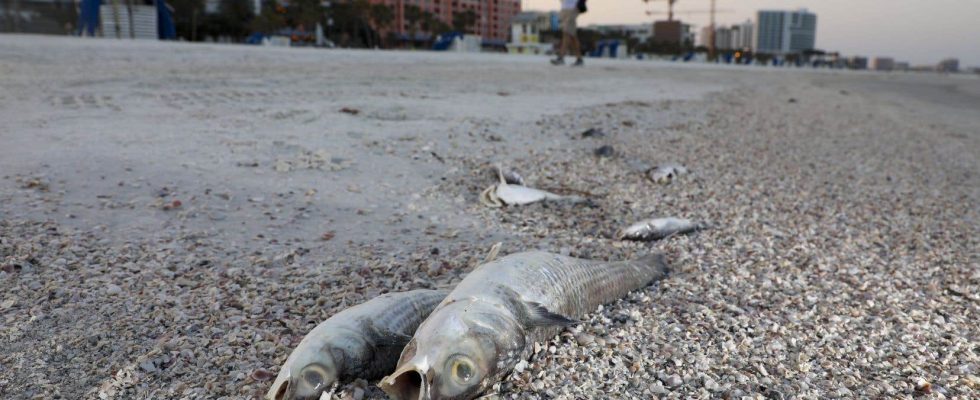A “tide” of toxic red algae has been poisoning the Florida coast for weeks. Not about to fade, this wave of natural pollution is decimating marine wildlife and posing serious health risks to residents and vacationers.
Sophie Carrière was hoping for a quiet vacation on the Florida beach in Sarasota. The Quebecer and her husband have been spending the winter with their feet in the sand of this heavenly corner since 1978. This year, a “red tide” of rare magnitude undermined their happiness.
“When I arrived on February 25, I walked to the water’s edge not knowing that there were difficulties with the red tide. It was the hundreds of dead fish and the smell that told me,” she says. “The beaches are empty because it’s unbearable. »
It is offshore that a few reddish streaks can be discovered which confirm the presence of a “red tide”. This phenomenon is the consequence of an extraordinary resurgence of “red algae”. These micro-organisms swarm in tropical waters and release toxic fumes, making the air pestilential. Ocean water becomes deadly to wildlife. A large part of the west coast of Florida has been deserted for weeks.
“We just choke on breathing,” explains Sophie Carrière. “Unable to suppress the cough. Then come the sneezing and for some, the eyes are runny and itchy like in allergy season. These algae are poisoning the lives of all coastal residents, she says, because “even in the pool, all the people are coughing all the time.”
Marine life suffers. As proof, thousands of dead fish litter the 300 kilometers of shoreline affected. This tide is so large that authorities have removed nearly 20 tons of dead animals from the beaches since December, local media report.
“They are in full sun on the sand and it smells bad. Even the scavenger birds don’t want it,” said the adopted Floridian.
Videos circulating on social networks illustrate the extent of the damage. You can see hundreds of fish of all sizes, dead, floating on the surface.
The Florida Fish and Wildlife Research Institute is scrambling to save large marine animals that wash up on beaches. Since the hatching of this wave of red algae began last October, their team has recovered the corpses of more than a hundred sea turtles. Some of them weigh more than 100 kilograms. A dozen lifeless manatees were also found inert on the beaches.
“No dolphins or pelicans on the horizon as before,” laments Sophie Carrière. “This is the first year that we have experienced such a thing. »
A natural problem amplified by humans
It’s actually not the first red tide that the hundreds of thousands of Floridians on the West Coast have had to experience. The First Nations of Florida were already recording this phenomenon hundreds of years ago. Small red tides appear almost every year. However, the duration and magnitude of the 2023 red tide is striking.
“It’s not the worst we’ve seen, but it’s pretty terrible. It’s very early in the season,” says Shawn Landry, research director at the University of South Florida’s Water Institute.
Like the blue and green algae of our Nordic countries, these red algae multiply because of the nitrogen that humans release into nature. “People who put fertilizer on their lawn. It collects in the ocean and it feeds the red tide, explains the biologist. We, as a community, are not the cause of the red tide, but we make it worse. People have to understand that we are the problem. »
Red tides usually end naturally. “If we could get rain, the cool water would help solve the problem,” he notes. Impossible, however, to predict when this red tide will finally set sail.
Many expect this algal invasion to last at least another month. The annual BeachFest has already canceled its 2023 edition after determining, with the help of the city and the Pinellas County Health Department, that the red tide is likely to continue through mid- april.
